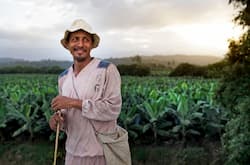Want to protect youthfulness? Start by firming up your handshake. The handshake is as ancient as the Egyptian pyramids (frescoes depicted it as early as 2800 B.C.). Across time, geography and culture, an extended hand has meant extended trust: A greeter couldn’t simultaneously hold a weapon and clasp hands. Medieval knights gave the clasp a good shake (to dislodge hidden weapons) and thus the handshake has been, well, handed down in human relations.
Putting your best hand forward is crucial to projecting confidence–but more subtly it may also provide a reliable indicator of age, and not just chronological age, but biological age (i.e., how fast or how slow the body is aging, regardless of actual years lived). In a new study published in PLOS ONE, researchers from Sony Brook University detail findings correlating aging with other age markers, such as cognitive decline, future mortality, disability, etc. “Our goal is to measure how fast different groups in a society age,” said co-author Dr. Sergei Scherbov. “If some group is getting older faster than another, we can ask why that might be.” For example, while handgrip strength declined with age across all population groups, educational attainment preserved handgrip strength longer, giving a 65-year-old high school dropout and a 69-year-old with higher education an equivalent handgrip strength.
The good news is that peeling back the years by improving the strength, youthfulness and quality of your handshake is literally within your grasp. Don’t unintentionally “age” your handshake with a limp clasp. When reaching for another’s hand, open wide the space between your fingers to ensure 100% contact between the palms of your hands, and wrap around the other person’s hand. Put down any cold drinks that might give you a cold and clammy hand, and rise to shake if you’re seated.
Needless to say, fitness is key to a strong grasp– and diet is key to fitness. Lifting weights will ward off muscle loss — and gerontologists say it’s never too late to start lifting! Indeed, regular exercise can keep you genetically ten years younger! Beyond handgrip strength, mental acuity, aerobic capacity, and better muscle tone, working out might help rejuvenate your DNA. Getting adequate vitamin B6–supplied abundantly by bananas, red bell peppers, fish, walnuts and Russet potatoes–might help support DNA repair. Spinach, specifically, may have muscle-building benefits, according to basic research recently pioneered by Professor Mary Ann Lila, who is a David H. Murdock Distinguished Professor and the Director of the Plants for Human Health Institute at North Carolina State University. “Some may scoff at the notion that spinach, despite containing nutrients, builds muscles,” observed Dr. Lila, “But Popeye may have been on to something.”
Published July 1, 2014



